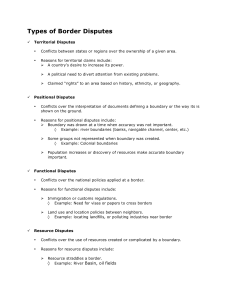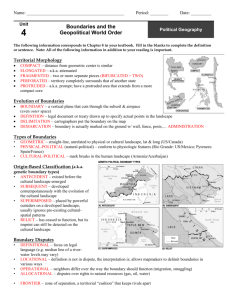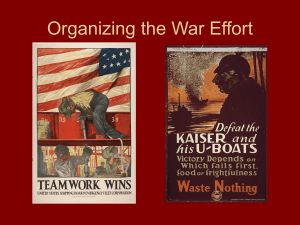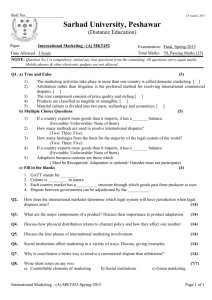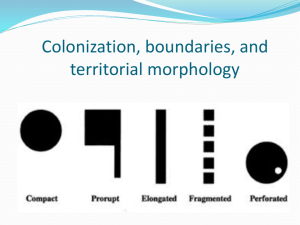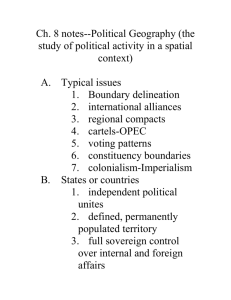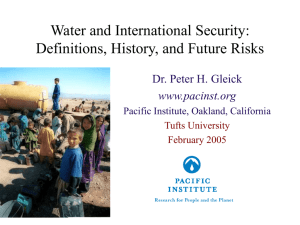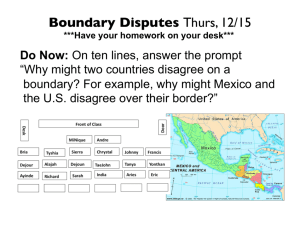Political #2
advertisement
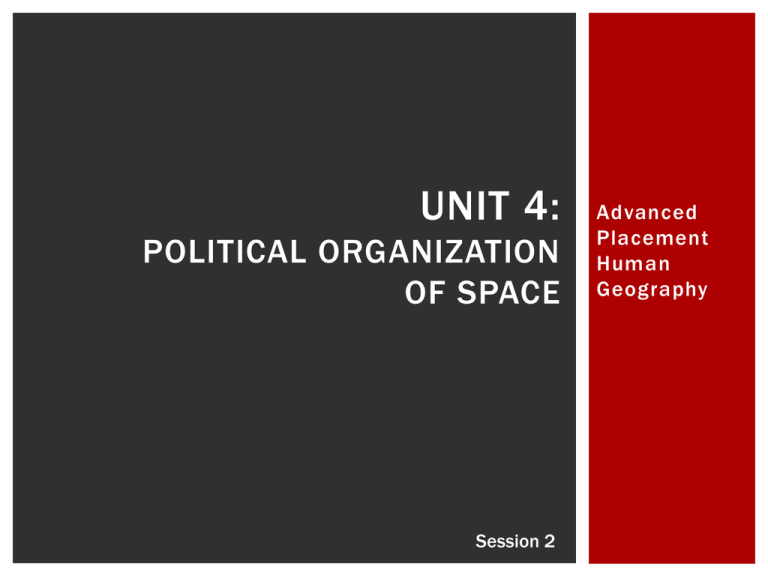
UNIT 4: POLITICAL ORGANIZATION OF SPACE Session 2 Advanced Placement Human Geography MORE ABOUT THE TERRITORIAL DIMENSIONS OF POLITICS SHAPES OF STATES CREATED BY BOUNDARIES CAN CREATE… Exclaves Enclaves Small bits of territory that lie on coasts separated from the state by the territory of another state Example: Cabinda, part of Angola separated by another country, the Democratic Republic of the Congo Landlocked within another country, so that the country totally surrounds it Example: NagornoKarabakh an enclave of Armenian Christians surrounded by Muslim Azerbaijan Region of major tension between Azerbaijan and Armenia SIZE OF STATES States’ sizes vary greatly Largest: Russia 6.5 million square miles 11% of Earth’s surface Smallest: Microstates such as Liechtenstein, Andorra, and San Marino Liechtenstein Liechtenstein is one of the world’s smallest states, called a “microstate.” It only encompasses a few square miles and is tucked in between two relatively small states, Switzerland and Austria. LARGE STATES Advantages Although it depends on location, large size increases the chances of having important natural resources mineral ores fertile soil Disadvantages Location can accessibility of resources. affect natural Examples: Russia and Canada So far north that much of their land is frozen Parts of the countries impossible to do farming or mining SMALL STATES Advantages They are more likely to have a homogeneous population so conflict is minimized. They may also wield power beyond their size. Example: Britain, with its many natural and human resources SIZE OF STATES Size alone is not critical in determining a country’s power and stability, but it is a contributing factor. ABSOLUTE AND RELATIVE LOCATION The significance of size and shape as factors in national well-being can be modified by a state’s location, both absolute and relative. ABSOLUTE LOCATION Example of country affected by its absolute location: ICELAND Advantage: Iceland has a compact shape. Disadvantage: Its location at 65° N latitude means that most of the country is uninhabited. Settlement is confined to the coastlines. RELATIVE LOCATION Landlocked states, those lacking ocean frontage and surrounded by other states are at a disadvantage for: Trade Sea resources Transportation Communication LANDLOCKED STATES Some Examples Asia: Nepal Mongolia Laos Bhutan Africa: Chad Botswana Rwanda Zimbabwe South America: Paraguay Bolivia Former Soviet Union: Moldova Uzbekistan Belarus RELATIVE LOCATION Sometimes relative location can be an asset for a state. Example: Singapore At the crossroads of international travel that links East Asia to South Asia Used its location to build industry and communication links One of the most prosperous states in the world today Historically, states and empires have built walls to mark the limits of their governmental control. The Great Wall of China The Berlin Wall FUNCTIONS OF BOUNDARIES The Great Wall of China The Great Wall as we see it today was built during the Ming Dynasty that ruled from the 13th to 17th centuries C.E. A much earlier wall was built starting in the 3rd century B.C.E., but little of that older wall remains today. For centuries, the wall served as the northern boundary of the Empire of China. BOUNDARIES Today, boundaries still mark the limits of state jurisdiction. Boundaries also serve as symbols of sovereignty, the ability of the state to carry out actions or policies within its borders independently from interference either from the inside or the outside. BOUNDARIES AND NATIONALISM The shape of a country’s territory comes to represent a national consciousness, or nationalism. Modern nationalism is a sense of unity with fellow citizens and loyalty to the state to promote its culture and interest over those of other nations. INTERNAL BOUNDARIES Many modern countries divide their interiors into sections marked by internal boundaries. Examples: United States: 50 states Canada: 10 provinces, 2 federal territories, and one self-governing homeland BOUNDARY DISPUTES Since Word War II, almost half of the world’s sovereign states have been involved in border disputes with their neighbors. The more neighbors a state has, the greater the likelihood of conflict. CATEGORIES OF BOUNDARY DISPUTES Positional (definitional) disputes These occur when states argue about where the border actually is located. Example: The boundary between Argentina and Chile It follows the crest of the of the Andes Mountains and the watershed, which do not always coincide. CATEGORIES OF BOUNDARY DISPUTES Territorial disputes These arise over the ownership of a region, usually around mutual borders. Conflicts arise if people of one state want to annex territory whose population is ethnically related to them. CATEGORIES OF BOUNDARY DISPUTES Territorial disputes 20th century example: German invasion of Czechoslovakia and Poland, areas with German minorities This type of expansionism is called irredentism. CATEGORIES OF BOUNDARY DISPUTES Resource (allocational) disputes These disputes involve natural resources that lie in border areas. Resources include: mineral deposits fertile farmland rich fishing groups Example: The U.S. and Canada have feuded over fishing grounds in the Atlantic Ocean. CATEGORIES OF BOUNDARY DISPUTES Functional (operational) disputes These arise when neighboring states cannot agree on policies that apply in a border area. Example: the ongoing immigration debate between the U.S. and Mexico EVOLUTION OF THE CONTEMPORARY POLITICAL PATTERN History has seen many different types of political organizations. City-states Empires Caliphates Kingdoms Feudalism STATES In today’s world, power is territorially organized into states, or countries. STATES What do states do? They define who can and cannot use weapons and force. They include institutions that help to turn political ideas into policy. They exercise sovereignty, the ability to carry out actions or policies within their borders. NATIONS V. NATION-STATES Nations A group of people bound together by a common political identity Nation-states Refers to a state whose territorial extent coincides with that occupied by a distinct nation or people Example: The Former Soviet Union When the country fell apart in 1991, it fell along ethnic boundaries into independent nation-states. Today Russia (one of the former soviet republics) remains a large multinational state that governs many ethnic groups. VARIATIONS OF THE NATION-STATE A binational or multinational state is one that contains more than one nation. without a state. A stateless nation. The Kurds have had a national identity for many centuries, but they have never had a state. Instead 20 million Kurds are spread in an area that crosses the borders of six countries: Turkey, Syria, Iraq, Iran, Armenia, and Azerbaijan. VARIATIONS OF THE NATION-STATE Stateless nations are a people KEY TERMS TO REVIEW FROM THIS SESSION Exclaves Enclaves Landlocked states Boundaries Sovereignty Nationalism Internal boundaries Positional disputes Territorial disputes Irredentism Resource (allocational) disputes Functional disputes States Nations Nation-states Stateless nations
